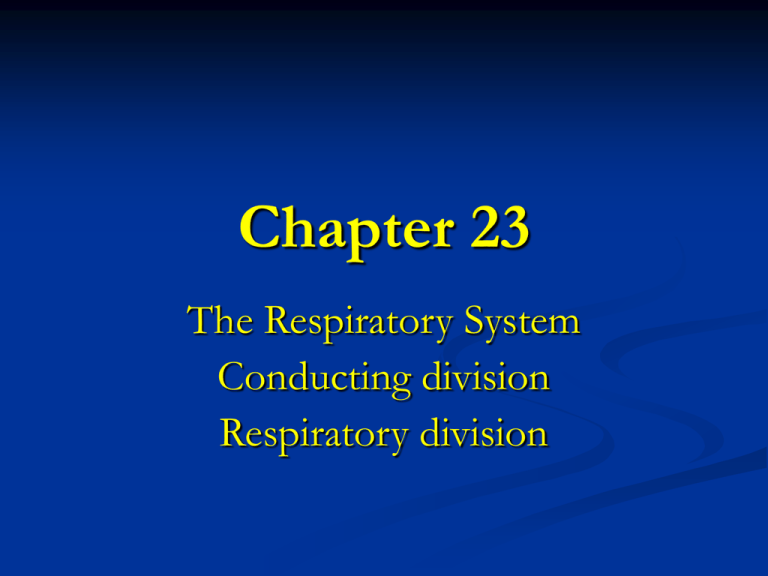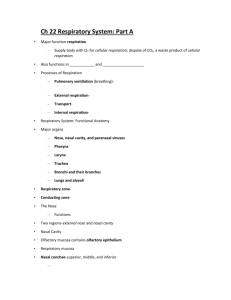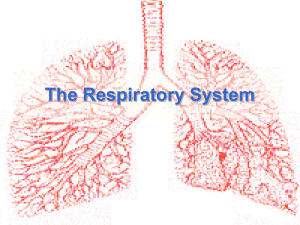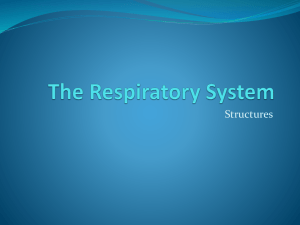Respiratory System
advertisement

Chapter 23 The Respiratory System Conducting division Respiratory division Respiratory system Functions to allow the exchange of O2 rich air from the atmosphere with the O2 poor air in lungs and the blowing off of CO2 in the process. Broken down into 2 zones: “Conducting zone” structures: nose, nasal cavity, pharynx, larynx, trachea and bronchioles. “Respiratory zone” structures: alveolar ducts, alveoli and alveolar sacs where gaseous exchange occurs across the capillary endothelium. Upper respiratory tract – extends from nares through the larynx. Lower respiratory tract – extends from larynx to alveolar sacs. Respiratory System Defined: Includes the nose, nasal cavity, pharynx, larynx, trachea and lungs. Respiratoy tree showing extensive branching Conducting division These structures serve for the exchange of air only (i.e. ventilation). No respiration occurs until the air reaches the respiratory structures (i.e. terminal brochioles, alveoli, etc.) in the respiratory zone. Nose and external nares External nose: covered by skin, it is the only part of the respiratory system exposed to the outside. External nares (nostrils) are openings from the outside into upper respiratory tract. Nasal cavity a) warms air; b) moistens air, and c) filters out large particulates before they reach the pharynx. Also serves for olfaction and as a resonating chamber for voice Nose The Pharynx: “Throat” Defined: posterior part of nasal cavity and oral cavity Consists of 3 divisions: nasopharynx - posterior nasal cavity, past internal nares; air passage way from nasal cavity to oropharynx oropharynx – passageway for air and food; extends from soft palate down to epiglottis laryngopharynx –passageway for air only, extends from epiglottis to larynx Nasal and oropharynx The Larynx: the “voice box” a.- opening into trachea from laryngopharynx b.- diverts air and food in correct directions c.- houses vocal cords 9 cartilages total (you are responsible for knowing the 4 below) Thyroid cartilage “Adams apple” Cricoid cartilage completely encircles upper trachea Arytenoid cartilage Epiglottis – made of elastic cartilage acts as a flap valve to close glottis during swallowing. The Larynx “voice box” 1. thyroid cartilage – “Adams apple” made of hyaline cartilage. - largest of the laryngeal cartilages 2. cricoid cartilage – hyaline cartilage - inferior to thyroid cartilage. 3. arytenoid cartilage – hyaline cartilage - true vocal cords are attached to these and they rotate laterally to tighten vocal cords for speech. 4. epiglottis – made of elastic cartilage - hood over glottic opening and deflects food and liquids away from glottis. Glottis is the opening into the trachea. Larynx “voice box” vocal folds/”true” vocal cords The Trachea: “windpipe” Cartilaginous tube going from larynx to hilus of lungs. basic tissue structure mucosa – lined with pseudostratified ciliated columnar epithelium- cilia are part of mucociliary escalator mechanism. Submucos - contains goblet mucous glands Tracheal cartilage – 16-20 “C” shaped rings of hyaline cartilage. adventitia – fibrous CT attached to perichondrium of rings. trachealis muscle joins end of “C”rings on posterior opening Bifurcates at “carina” into left and right primary bronchus. The Trachea: “windpipe” Cilia and goblets cells with microvilli in trachea Bronchial tree Conducting division: R/L Primary Bronchi – right mainstem bronchus comes off 1st and is more vertical, as a result foreign objects getting into trachea are more likely to enter right mainstem bronchus. Secondary Bronchi – lobar bronchi - right side – three secondary bronchii -left side – two secondary bronchi Tertiary Bronchi – segmental bronchi -divide repeatedly into smaller and smaller bronchi Bronchioles – air passages < 1 mm in diameter Terminal Bronchioles – air passages < .5 mm in diameter Respiratory division Is found only in the lungs beginning at terminal bronchioles Includes terminal bronchioles, alveolar ducts, alveoli and alveolar sacs where gaseous exchange occurs across the capillary endothelium. Allows the exchange of respiratory gases (O2 &CO2) from alveolar space into blood and to be bound to Hgb in RBC’s The LUNGS Respiratory division defined by the presence of alveoli respiratory bronchioles – give rise to alveolar ducts alveolar ducts – walls consist of rings of smooth muscle alveolar sacs – terminal clusters of alveoli alveoli – ~300 million and account for greatest protion of lung volume and a large surface area for air exchange Respiratory division Respiratory division anatomy Alveolar sac cell types type I cells – alveolar cells; squamous cells that cover 95% of alveolar surface where gas exchange occurs. type II cells – alveolar septal cells comprise other 5% of alveolar cells and produce “surfactant” that keeps alveoli from collapsing and sticking together. alveolar macrophages – dust cells; most numerous of alveolar cells. Housekeepers of the alveoli. Alveolar sac anatomy Pleural membranes Serous Membranes: similar to pericardium and consists of: visceral pleura – closely adhered to lung tissue proper. parietal pleura – lines the thoracic cavity. pleural fluid/space – clear plasma ultrafiltrate that fills pleural cavity and reduces friction when lungs inflate and deflate. Lung anatomy Occupy greatest portion of thoracic cavity. Weigh ~ 0.6 #’s Left lung- 2 lobes Right lung- 3 lobes Lobes made up of lobules, which are smallest division of lungs. Bronchi and vessels enter lungs at hilus. Base rests on diaphragm Apex is top of lung Lung tissue is primarily of elastic connective tissue. Blood supply to lung tissue is via bronchial vessels off of aorta. Bronchopulmonary segments Muscles involved in breathing Most important muscle is diaphragm and it descends as we inhale. Next most important are the external and internal intercostal muscles which help to elevate the ribs in a “bucket handle” motion. Accessory muscles include: Inhalation- serratus anterior, sternocleidomastoid, scalenes pectoralis minor. Exhalation- rectus abdominis, external obliques, transversus thoracis Muscles involved in breathing Thoracic cavity changes Neural control of respiration Normal breathing occurs automatically but are regulated by 3 reflex mechanisms. [Mechanoreceptors (vol and abp), chemoreceptors (pH, pCO2, & pO2) and Protective reflexes (injury or irritants to respiratory tract)] Three pairs of regulatory centers exist in the reticular formation of the pons and medulla. The respiratory rhythmicity center regulates rate and depth The apneustic center causes strong sustained inspiration The pneumotaxic center inhibits the apneustic center stopping inspiration The latter two centers modify the pace and rhythm of respiration based on information from higher centers (cortex, limbic system and hypothlamus) Neural control of respiration






